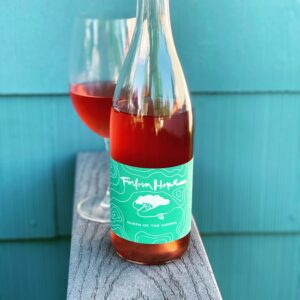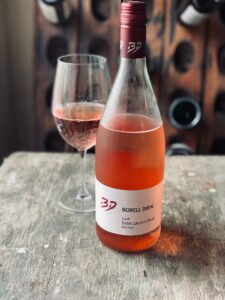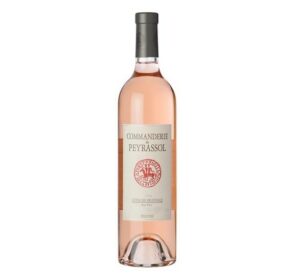It would be quite impossible to include every rosé I love in one article, simply because there are more well-made wines in this category than ever before. For a wine lover like myself, this is really exciting. This year I set a new goal this of trying as many different pink wines as I possibly can. In this post, I’ve included 15 of the rosés I’ve enjoyed the most … thus far. I’ve got several left to try, so expect a part 2 later in the summer!
What exactly is rosé wine? I have had many people ask this question, and this past Wednesday during my weekly Wine Wednesday FB live, I talked about this genre and answered some questions. But in short, rosé wines are made from red grape varieties and can be made from any and all kinds of varieties like Grenache, Syrah, Cabernet Sauvignon, Pinot Noir, Nebbiolo and many more.
You might wonder, how does rose wine get its color from? All grape juice, whether it’s from red or white grape varieties, run clear in color. The color comes from being contact with the skins of the red grapes, and the grade of color depends on how long the juice has been allowed this contact.
There are essentially three main methods used to make rosé:
The most common method is the maceration method, where the juice is left to macerate with the skins until the winemaker achieves the desired color.
Pressing is another technique of pressing the red grapes until the juice gets the color the winemaker is looking for. Only the pressed juice is used to make the rosé wine.
The saignée method or bleeding, happens when making a red wine, and some of the wine is ‘bled off’ and put into a new vat to make a rosé wine. These are typically darker in color and richer in style. This process tends to produce the lightest colored rosés and accounts for about 10% of rosé production.
The wine region best known for creating a wide variety of rosés is Provence. Provence creates rosé more than any other style of wine. In fact, it accounts for a whooping 90% of their wine production. You can find these pink wines at all price points, and on average the quality is quite good. A rosé from Provence is therefore typically a safe bet if you feel like drinking pink. I look for Tavel, Bandol and Cassis for really wonderful examples.
Provence aside, there are fabulous examples coming out of Spain, Portugal, Italy, Germany, Austria, California, Oregon, Chile, Australia and even my home state of New York. Anywhere where wine is made, you most likely will find a rosé.
Serve rosé wine between 50-60 degrees, and while they make a wonderful cocktail wine, they are also very food friendly and can match up to a variety of dishes. Depending on the style, I like to drink rosé with anything from hummus and pita, vegan crab cakes and ‘tuna’ salads to rice dishes like paella, stir fries, spicy curries and beet burgers.
Rosé is typically not a very expensive wine. If you want, you can spend more, but a higher price doesn’t necessarily mean increased quality. Much like you can spend $30 on a burger, you can find an equally satisfying one at $10. Rosé works in a similar way. Personally, I like to spend between $15-20 for my go-to rosés, but never more than $30 and then it really has to be a unique wine. If you’re interested in trying higher end rosés, try producers like Domaine Tempier Bandol, Domaines Ott Chateau Romassan Bandol, Chateau d’Esclans Rosé or Clos Cibonne Côte de Provence Tibouren Cuvee Speciale des Vignettes Roses, to name a few.
Below are some of the wines I’ve tried so far this year that I really enjoyed. If you have tried any of these and want to chime in, or have any additional recommendations, I would love to hear from you!
***********************************************
Domaine La Bastide Blanche Rose Bandol 2018
Bandol produces some of France’s most distinguished roses, and La Bastide Blanche Rose 2018 is no exception. Made with 75% Mourvedre, and the rest Grenache, Cinsault and a little Clairette, this wine has a gorgeous orange color with a beautiful nose of raspberries, blood oranges and peaches. It has a juicy palate and loads of candied strawberries on the palate with zesty acidity intermingled with white pepper and a herbaceous finish. Pair with a Provençal inspired roasted tomato tart, ribbon zucchini salad or gazpacho.
Price: approximately $20.

Weingut Beurer Rosé Trocken Württemberg 2018
This is a certified organic, biodynamic and low intervention wine from Würtemberg, Germany. I love that this estate focuses on ecology and preserving the environment. The grapes are crushed by foot, and the wine goes through spontaneous fermentation with native yeasts in stainless steel tanks. Made by a former European BMX Champion turned winemaker, this is a blend of Trollinger (Schiava), Portugieser, Rotburger (Zweigelt) and Spätburgunder (Pinot Noir) and the wine is produced by the saignée method. Rich, full bodied with plenty of strawberry, raspberry, citrus and melon, this is a refreshing wine you’ll keep coming back to! Price: About $20.

Forlorn Hope Queen of the Sierra Rosé 2018
A wonderful rosé from the Sierra Foothills in California that’s a blend of Barbera and Zinfandel. Organic, hand harvested grapes, whole cluster pressing and spontaneous fermentation. Unfined, unfiltered with minimal SO2 added at bottling. Bright watermelon color, with flavors of ripe strawberries and watermelon, coupled by balanced acidity and minerality. A winery to check out as their other wines are great too. Price: about $24

Borell Diehl Sankt Laurent Rose Trocken 2018
This is my go-to rosé for big parties, as it comes in a liter bottle and is incredibly refreshing and with a slight spritz to it. The best bargain in the lot, this wine comes from the Pfalz region of Germany, and is made from the Sankt Laurent grape. Organic and sustainably dry farmed, this is dry, refreshing with lots of bright cherries. A simple, yet delicious and easy-to-drink crowd pleaser that will be a hit at summer parties. Price: $14

Minimus Illegal Rose 2016 (Chad Stock)
This is definitely one of the most memorable rosés I’ve had this year. From Chad stock in Oregon, this is a blend of Schioppettino, Savaginin Rose, Furmint, Arbouriou and Pinot Gris. With the exception of the latter grape, not exactly varieties you associate with Oregon – which is why I found it so interesting! Truly mind-blowing layers of flavors of stone fruit, berries, honeydew melon and even some savory notes. This is called “Illegal” because technically internationally it is illegal to blend red and white grapes, as Chad has done here. The result is stunning! Price: $24

Commanderie de la Bargemone 2018
From one of the top estates in Coteaux d’Aix in Provence, which produces benchmark dry and delicious rosés typical of the region. A blend of 40% Grenache, 25% Cabernet Sauvignon, 20% Syrah, 10% Cinsault, and 5% Rolle. All grapes are farmed organically, this has classic strawberry flavors with red currants and floral notes. A rosé I’d happily drink year round. Price: about $15.

Domaine Skouras Zoe Rose 2018
I’ve got a special love for Greek wines, so when I saw this inexpensive bottle I had to grab it immediately, and was pleasantly surprised by the quality. From the Peleponnese region, this rosé is made from 70% Aghiorgitiko and 30% Moschofilero; another red and white grape blend that delights on the palate. Ripe cherries, raspberries and white flowers on the nose, the wine is medium bodied with good fruit and balanced acidity in the mouth. Refreshing and very budget friendly at only about $12. Pair with Greek salads, spanakopita and falafels with tzatziki for a great Greek/Middle Eastern feast!

Meinklang Frizzante Rose 2017
A fun, sparkling Pinot Noir from Burgenland in Austria from the Michelitis family, who live and exist within a complete biodynamic environment. Ever since they took over their family farm over 20 years ago, they have sought a close co-existence with nature. Slightly off dry, with juicy strawberry flavors, this fizzy wine is wonderful with BBQ and all kinds of summery salads. Check out their other wines too – great values and always good quality. Price: about $18.

Cantina Marilina Fedeli Rosato Frizzante (Pet Nat)
Cantina Marilina is an organic winery located in southeastern Sicily headed by sisters Marilina and Federica Paterno. The winery is surrounded by a UNESCO World Heritage site and wildlife sanctuaries, and the sisters are committed to use traditional, environmentally friendly methods to make natural wines that speak of the terroir. They use recycled natural paper for labels, no capsule and light glass, in an effort to carry as little environmental impact as possible.
All their wines are fermented with indigenous yeast, and fined with natural products (no animal by-products) so vegan-friendly. This is a fantastic Pet Nat rosé from 100% Nero d’Avola with beautiful aromas of cranberries, watermelon, lemon zest, wildflowers and red currants. These flavors carry over to the fruit forward, medium bodied, fizzy palate. A chuggable wine that just begs to be enjoyed on hot summer days! Price: about $25.

Vini Contestabile Rosato 2017
One of the funkier rosés of the group for sure, this is from Danilo Marcucci in Umbria, Italy. The front label reads: “No chemistry in the vineyard, no technology in the cellar”. Completely natural from handpicked Sangiovese, Malvasia Nera and Grenache, spontaneous co-fermentation, no sulfur added at any time. Unfined, unfiltered and bottling is done by hand. A wonderfully complex wine that will leave you thinking about rosé in a different way! Pair with your favorite tomato based pasta dish. Price: $20
![]()
Domaine des Corbillières Rose Touraine 2016
A wonderful example of a Loire Valley rosé from 70% Pinot Noir and 30% Pinot d’aunis, made by two ladies: Dominique and Véronique Barbou, who’s at the helm of Domaine des Corbillières. They take a low intervention approach, fermenting only with native yeasts, and no additives are put in the wines. Flavors of crushed red berries combined with nice herbaceous, savory notes, with delightful minerality and crisp acidity, this is an impressive rosé at an approachable price of about $16.

Nathan K. Pinot Noir Rose 2017 (Finger Lakes)
Made from 100% Pinot Noir, sourced from Seneca Lake vineyards, this was direct pressed and fermented and aged in neutral French oak. Nathan’s wines are made from carefully sorted grapes, go through spontaneous fermentation and never fined and only lightly filtered. Definitely a more savory versus fruity rosé, a tad funky with lots of texture and complexity. A wine to seek out for sure, if you are adventurous and can find it! Price: Approximately $20.

Stolpman Vineyards Para Maria de las tecolotes Rose 2018 (Santa Barbara, CA)
Another fun and surprising rosé made from Santa Barbara, CA and a blend of 60% Syrah, 20% Cabernet Sauvignon, 10% Grenache and 10% Merlot. The winemaker is Ruben Solorzano, and named the wine in honor of his wife (who also helps with winemaking) Maria and her home town, Tecolote, which means night owl. Para Maria is a 50-50 partnership between the Stolpman and Solorzano families.
Depending on the lot, the juice was either direct-pressed or crushed and soaked up to 3 hours before pressing. Native fermentation in stainless steel tanks, this is a full bodied wine with flavors of pineapple, mango and papaya, finished with red grapefruit and a racy acidity to match. Would love these with all types of tacos or grilled vegetables! Price: approximately $20.

Botromagno Rose di Lulu 2018
Made from 50% Nero di Troia and 50% Montepulciano from a single vineyard in Puglia, Italy grown at high elevation (700 meters) – this has a gorgeous, pink color with orange tins, with plenty of red berries, citrus peel and cherry flavors with commanding structure and lots of gorgeous acidity and minerality. Definitely get this if you find it, and pair with summery pasta salads, bruschetta and caponata. Price: About $18

Maz Caz Rose 2017
Made by Michele d’Aprix, who also happens to be the winemaker at Chateau Beausejour in Bordeaux, she lives in New York where she also runs a wine importing business. At harvest times you can find her in France, however. A few years back, she decided to spread her wings and to make wines in Costieres de Nimes, where this rosé was born. This is a great value appellation just south of the Rhone Valley – and this wine is a blend of Syrah, Grenache and Mourvedre. Dark, juicy fruit with a touch of smoke, this is another fun find I would pick up if you come across it. Price: around $16.

Commanderie de Peyrassol 2018
Another classic Provence rosé from a top quality estate, Commanderie de Peyrassol, founded in the 13th century. The “Commanderie” is the classic workhorse rosé of the estate, made by female winemaker Hermine Clemont. Comprised of roughly equal parts Cinsault and Grenache, with a little Syrah and Rolle. A beautiful pale salmon color, this is a fresh and energetic rosé with the familiar Provençal refined strawberry, blackberry and citrus fruit with a touch of salinity. Pair with your favorite vegan cheeses. Price: about $19.

Sans Rose of Carignan 2017
Canned wines are becoming increasingly more popular this year, and when you get quality like the ones you find from Sans, I welcome this new trend! The fruit in this wine comes from Poor Ranch Vineyards in Mendocino County, where 3 different Carignan blocks are fermented naturally and aged separately in stainless steel before blended together. The average vines of the Carignan is 50 years.
This is a soft, medium bodied wine with plums, red currants and earthy tones, delicate tannins and balanced acidity and a light peppery finish. Really pretty and well made. Certified organic. Check out their other wines in cans too, especially the Sauvignon Blanc and Zinfandel. Price per can (375ml): Approximately $10




0 Comments